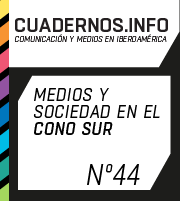Construcción de la imagen país Cuba: análisis de la conformación de la identidad nacional desde el spot publicitario
DOI:
https://doi.org/10.7764/cdi.44.1559Palabras clave:
imagen país Cuba, publicidad en televisión, signos publicitarios, figuras retóricas, semióticaResumen
Este artículo tiene como objetivo caracterizar la imagen país Cuba mediante los spots transmitidos por Cubavisión Internacional. Para el desarrollo de las categorías de análisis se aplica el método análisis de contenido. Entre los resultados de la investigación, se determina que los spots publicitarios analizados representan de modo deficiente la imagen país Cuba, a partir de temas y signos publicitarios estereotipados y tópicos poco representativos de la nación. Los signos publicitarios se emplean para referir rasgos de la población cubana y promover el turismo, la hostelería y el consumo de productos nacionales.
Descargas
Citas
Bassat, L. (2001). El libro rojo de la Publicidad (Red Book of Advertising). Madrid: Random House Mondadori.
Bueno Doral, T. (2012). Estereotipos de género en los orígenes de la publicidad: la imagen femenina en el cartel artístico (Gender stereotypes in the origins of advertising: the female image in the artistic poster) (Doctoral dissertation). Retrieved from https://eprints.ucm.es/16173/
Capriotti, P. (2013). Planificación Estratégica de la Imagen Corporativa (4ª ed.) (Strategic planning corporate image (4th ed.)). Málaga: Instituto de Investigación en Relaciones Públicas. Retrieved from http://www.bidireccional.net/Blog/PEIC_4ed.pdf
Cardús, S. (2010). La identitat, reconeixement i diferenciació (Identity, recognition and differentiation). Paradigmes: Economia Productiva I Coneixement, (5), 17–23. Retrieved from http://www.raco.cat/index.php/Paradigmes/article/view/217274/296291
De San Eugenio, J. (2013). Fundamentos conceptuales y teóricos para Marcas de Territorios (Conceptual and theoretical foundations for territory brands). Boletín de La Asociación de Geógrafos Españoles, (62), 189–211. https://doi.org/10.21138/bage.1575
Díaz-Guzmán, K. (2015). Fundamentos de Publicidad para Comunicadores Sociales (Fundamentals of Advertising for Social Communicators). Colombia: Editorial Crucet y Asociados.
Doucet, A. V. (2008). Análisis de contenido y propuesta de metadatos para la representación documental de la fotografía científica: un estudio de casos (Content analysis and metadata proposal for the documentary representation of scientific photography: a case study) (Doctoral dissertation). Universidad de Granada. Retrieved from http://hdl.handle.net/10481/1816
Hernández-Sampieri, R., Fernández, C., & Baptista Lucio, P. (2006). Metodología de la investigación (4ª ed.) (Research methodology (4th edition)). Mexico City: McGrawHill Interamericana.
Hernández, B. & Rajas, M. (2013). Narrativa publicitaria audiovisual: el spot emocional (Audiovisual advertising narrative: the emotional spot) (Degree Thesis). Universidad Rey Juan Carlos.
Jenes, B. & Malota, E. (2009). Measuring Country Image - Theory and Practice. In Proceedings of the 8th International Congress Marketing Trends (pp. 16-17). Paris.
Kleppner, O., Rusell, J. T., & Lane, W. R. (1994). Publicidad (12ava ed.) (Advertising Procedure (12th ed.)). Mexico City: Prentice-Hall Hispanoamérica S.A.
Kotler, P., Haider, D. H., & Rein, I. (1994). Mercadotecnia de localidades: cómo atraer inversiones, industrias y turismo a ciudades, regiones, estado y países (Marketing Places – Attracting Investment, Industry and Tourism to Cities, States and Nations). Mexico City: Diana.
Laguna Platero, A. (2003). El poder de la imagen y la imagen del poder. La trascendencia de la prensa satírica en la comunicación Social (The power of the image and the image of power. The transcendence of the satirical press in the social communication). I/C. Revista Científica de Información y Comunicación, (1), 111-129. Retrieved from icjournal-ojs.org/index.php/IC-Journal/issue/download/22/23
Lippmann W. (1964). La opinión pública (Public opinion). Buenos Aires: Compañía General Fabril Editora.
Martín, M. (2008). La mediación social (Social mediation). Madrid: Akal.
Martin, I. M. & Eroglu, S. A. (2011). Scales Related to Country Image and Affiliation. In W. O. Bearden, R. G. Netmeyer, & K. L. Haws (Eds.), Handbook of Marketing Scales: Multi-Item Measures for Marketing and Consumer Behaviour Research (pp. 82–83). London: Sage.
Nogué, J. & De San Eugenio, J. (2009). Pensamiento geográfico versus teoría de la comunicación. Hacia un modelo de análisis comunicativo del paisaje (Geographical thought versus theory of the communication. Toward a communicative landscape model). Documents d’Anàlisi Geogràfica, (55), 27–55. Retrieved from https://www.raco.cat/index.php/DocumentsAnalisi/article/view/171748/224066
Ortega, E. (2004). La comunicación publicitaria (Advertising communication). Madrid: Pirámide.
Ortigueira, M. (1999). La imagen de un país y su gobierno. La imagen de Alemania (The image of a country and its government. The image of Germany). Dirección y organización: Revista de dirección, organización y administración de empresas, (22), 72-84. Retrieved from https://www.revistadyo.es/index.php/dyo/article/view/279
Pérez, J. P. (2009). El ritmo del spot de televisión actual. Narrativa audiovisual y categorías temporales en el palmarés del Festival Cannes Lions 2007 (The Rhythm in The Television Commercial Now. Audiovisual Narrative and Temporal Categories in The Winners of 2007 International Advertising Festival Cannes Lions). ZER: Revista de Estudios de Comunicación, 14(27), 103–124. Retrieved from http://www.ehu.eus/ojs/index.php/Zer/article/view/2402
Pessi, M. S. (2008). Sonia Madrid Cánovas. Semiótica del discurso publicitario: del signo a la imagen (Sonia Madrid Canóvas. Semiotics of advertising discourse: from the sign to the image). Literatura y Lingüística, (19), 333–337. Retrieved from http://ediciones.ucsh.cl/ojs/index.php/lyl/article/view/1592/1472
Ricardo, R. (2014). Prensa e imagen. Cuba ante el espejo de la realidad (Press and image. Cuba before the mirror of reality). Temas, (77), 49–55. Retrieved from http://www.temas.cult.cu/revista/77/imagen-pa%C3%ADs
Szeles, P. (1998). The Credit of Reputation. Image and Identity. Budapest: Star PR Ügynökség.
Tuan, Y. F. (1977). Space and place: the perspective of experience. Minnesota: University of Minnesota Press.
Villafañe-Gallego, J. (1993). Imagen positiva: Gestión estratégica de la imagen de las empresas (Positive image: Strategic management of companies’ images). Madrid: Pirámide.















